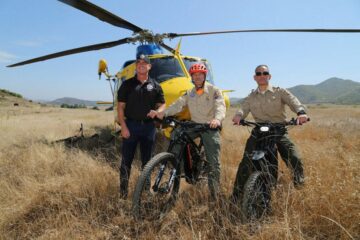Hiking safely requires common sense
Doing research and being well-prepared can make all the difference when it comes to hiking through the local hills and mountains.
Source of this article: The Thousand Oaks Acorn, May 2, 2013
Whether you’re a beginner or an experienced hiker, the best way to stay safe during a hike is to know what you’re getting into before you leave the house, says Capt. Anthony Romero of the Ventura County Fire Department.
“Always do your research before you go,” he said. “Websites are a fantastic resource. There is a lot of good information out there for Ventura County hiking areas and state park areas. And you can never be too prepared for anything, even something such as a day hike.”
The Ventura County Fire Department responds to hundreds of hiker rescue calls every year throughout the region’s parks and rural areas, Romero said.
While few require extreme medical attention or rescue efforts, most of the calls come from hikers who get lost simply because they’ve strayed from trails, he said.
Getting lost in rough terrain can often be avoided.
“There might not always be trail maps at the trailhead,” said Kate Kuykendall, public affairs officer for the Santa Monica Mountains National Recreation Area. “It’s always a good idea to do your homework before you go. You can print out a map before you leave and carry it with you on the hike.”
Common dangers
The Santa Monica Mountains National Recreation Area, which stretches along the California coast from the Oxnard Plains to the Hollywood Hills, includes nearly 500 miles of trails for hikers to explore.
The Santa Susana Mountains in Simi Valley, the Conejo mountain area and many other parks in between also offer adventurous opportunities for hikers.
Each trail has unique features, but many share common dangers.
“One of the biggest things to watch out for right now is ticks,” Kuykendall said.
“We recently had tests come back with ticks testing positive with Lyme disease.”
Lyme disease, characterized by flu-like symptoms, joint pain and a large rash around the tick bite, can affect the nervous system and cause bouts of arthritis.
Rattlesnakes, which are indigenous to the area, could also pose a threat. The California Poison Control Center estimates that rattlesnakes are responsible for more than 800 bites each year, with some resulting in death.
“It’s really about paying attention to where you’re walking,” Kuykendall said. “Fortunately, rattlesnakes come with their own alarm system. But if you see a snake on the trail, either give it a wide berth and go around it or wait patiently for it to leave before you go ahead.”
Poison oak, which causes extreme allergic reactions and itching if it comes into contact with skin, grows in abundance in the area.
“One of the most important things is to stay on the trail,” Kuykendall said. “If you stay on the trail, you’re more likely to avoid the poison oak, rattlesnakes and ticks.”
Supplies and skills
Not every hiker is welltrained in survival skills. But all can benefit from bringing basic supplies and a little bit of knowhow to the trails.
Romero and Kuykendall agree that all hikers should keep hydrated and bring enough water to last throughout the excursion.
“We have a Mediterranean ecosystem here, a very rare ecosystem characterized by hot, dry summers and mild winters,” Kuykendall said. “The hot, dry summer is certainly a factor when it comes to survival. It’s definitely a reason why people should drink lots of water when they go hiking.”
Romero also suggests bringing a fully charged cellphone, a light jacket, a whistle and a signal mirror, which can be used to reflect sunlight and catch the attention of others.
“Hikers always want to travel light, but this type of gear weighs very little and can be of great assistance in a rescue,” he said.
Long pants and shirts with long sleeves that are light in color can also prevent tick bites, because they keep the skin covered and make it easy to spot dark insects, Kuykendall said.
Above all, the “key survival skill” when it comes to hiking, Romero said, is to remember that there is “safety in numbers.”
“Never go hiking alone if you can help it,” the fire captain said. “But if you are going alone, always let someone know you’re heading out for a hike.
“Giving someone your expected time back can be very helpful in things like initiating a search.”
Most Ventura County fire stations can provide visitors with information about local trails and parks.
The VCFD at http:// fire.countyofventura.org also provides up-to-date weather warnings and high-heat and high-wind alerts.



0 Comments